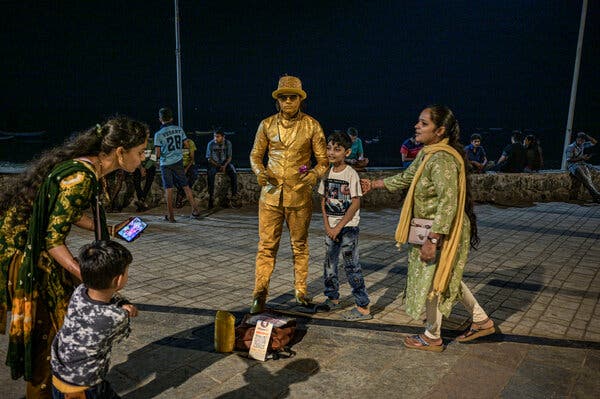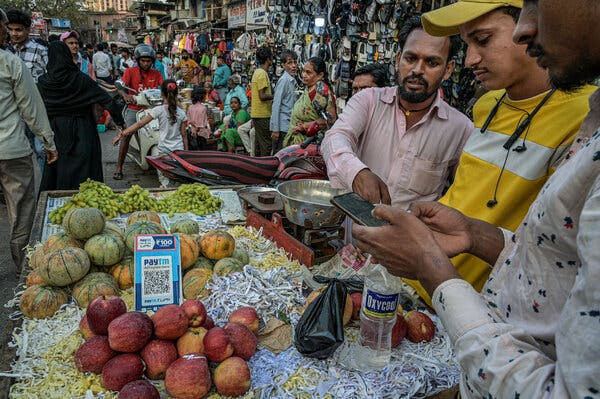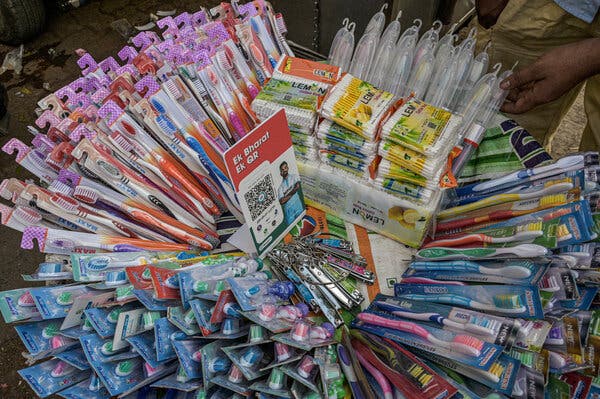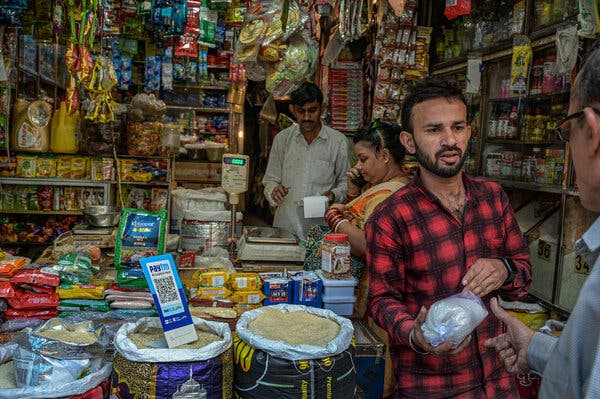Where Digital Payments, Even for a 10-Cent Chai, Are Colossal in Scale
India’s homegrown instant payment system has remade commerce and pulled millions into the formal economy.By Mujib Mashal and Hari Kumar
Reporting from New Delhi, Mumbai and Kerala in India
March 1, 2023
The little QR code is ubiquitous across India’s vastness.
You find it pasted on a tree next to a roadside barber, propped on the pile of embroidery sold by female weavers, sticking out of a mound of freshly roasted peanuts on a snack cart. A beachside performer in Mumbai places it on his donations can before beginning his robot act; a Delhi beggar flashes it through your car’s window when you plead that you have no cash.
The codes connect hundreds of millions of people in an instant payment system that has revolutionized Indian commerce. Billions of mobile app transactions — a volume dwarfing anything in the West — course each month through a homegrown digital network that has made business easier and brought large numbers of Indians into the formal economy.
The scan-and-pay system is one pillar of what the country’s prime minister, Narendra Modi, has championed as “digital public infrastructure,” with a foundation laid by the government. It has made daily life more convenient, expanded banking services like credit and savings to millions more Indians, and extended the reach of government programs and tax collection.
With this network, India has shown on a previously unseen scale how rapid technological innovation can have a leapfrog effect for developing nations, spurring economic growth even as physical infrastructure lags. It is a public-private model that India wants to export as it fashions itself as an incubator of ideas that can lift up the world’s poorer nations.
Image

A street performer with a code for donations.Credit...Atul Loke for The New York Times
“Our digital payments ecosystem has been developed as a free public good,” Mr. Modi said on Friday to finance ministers from the Group of 20, which India is hosting this year. “This has radically transformed governance, financial inclusion and ease of living in India.”
In simple terms, Indian officials describe the digital infrastructure as a set of “rail tracks,” laid by the government, on top of which innovation can happen at low cost.
At its heart has been a robust campaign to deliver every citizen a unique identification number, called the Aadhaar. The initiative, begun in 2009 under Mr. Modi’s predecessor, Manmohan Singh, was pushed forward by Mr. Modi after overcoming years of legal challenges over privacy concerns.
The government says about 99 percent of adults now have a biometric identification number, with more than 1.3 billion IDs issued in all.

Digital payments have become common for even the smallest purchases.Credit...Atul Loke for The New York Times
Nandan Nilekani, a co-founder of the information technology giant Infosys who has been involved in India’s digital identification efforts since their early days, said the country could make a technological leap because it had little legacy digital infrastructure in place. “India was able to develop afresh with a clean slate,” he said.
The IDs ease the creation of bank accounts and are the foundation of the instant payment system, known as the Unified Payments Interface. The platform, an initiative of India’s central bank that is run by a nonprofit organization, offers services from hundreds of banks and dozens of mobile payment apps, with no transaction fees.In January, about eight billion transactions worth nearly $200 billion were carried out on the U.P.I., according to Dilip Asbe, the managing director of the National Payments Corporation of India, which oversees the platform.

Dilip Asbe, the managing director of the National Payments Corporation of India, which oversees the digital payments platform, at its offices in Mumbai.Credit...Atul Loke for The New York Times
The value of instant digital transactions in India last year was far more than in the United States, Britain, Germany and France. “Combine the four and multiply by four — it is more than that,” as one Indian cabinet minister, Ashwini Vaishnaw, told the World Economic Forum in January.
The system has grown rapidly and is now used by close to 300 million individuals and 50 million merchants, Mr. Asbe said. Digital payments are being made for even the smallest of transactions, with nearly 50 percent classified as small or micro payments: 10 cents for a cup of milk chai or $2 for a bag of fresh vegetables. That is a significant behavioral shift in what has long been a cash-driven economy.
ADVERTISEMENT
Continue reading the main story
One impetus for the move away from cash and toward digital payments was Mr. Modi’s 2016 decision to remove all large-denomination currency from the market. Promoted as an effort to eradicate black money in politics, the shock devastated small businesses that ran on cash.
Image

The QR codes have made life easier for millions.Credit...Atul Loke for The New York Times
Reliance on the digital infrastructure deepened during the pandemic, as the government used the ID numbers to manage the world’s largest vaccination drive and deliver financial aid.
As the system has become embedded in Indian life, the concerns over data privacy have not fully receded, even after Supreme Court rulings governing its use. Some worry that the sharp erosion of checks on government power under the strongman rule of Mr. Modi could open the door to abuses of the central identity database. With India pushing its model abroad, including in countries lacking strong legal safeguards, these concerns will follow.
Amitabh Kant, one of India’s top coordinators for the Group of 20 events, said the government had struck the right balance between privacy and innovation. “We said that the data belongs to the individual and that he has the right to give consent for every transaction that he undertakes,” he said.
Image

The digital payments system has brought many people into the formal economy.Credit...Atul Loke for The New York Times
In two dozen interviews across villages, small towns and cities, a varied picture of digital payments emerged. In a pair of village shops in the northern state of Uttar Pradesh, they made up about 10 percent of daily sales; in the busier markets of Delhi, that number could be a quarter or half.
ADVERTISEMENT
Continue reading the main story
Even in sectors that have not yet adopted digital payments, like the fishing industry in the southern state of Kerala, the basic pillars of the digital infrastructure — the identity number, bank accounts and mobile phone apps — made it easier to deliver services.
In markets where digital payments have taken hold, the raw excitement of the newly converted is palpable. App companies are working to ensure ease of use across a wide spectrum of digital literacy. Merchants on the same sidewalk help one another. And because this is technology we are talking about, children come to the aid of parents.
Image

Billions of transactions take place each month.Credit...Atul Loke for The New York Times

Small voice boxes provided by payment apps are a fixture at snack carts and tea stalls, where vendors are too busy to check phone messages after every small transaction. A Siri-like voice declares how much money was instantly received with each payment by QR code. This has helped bridge mistrust among merchants long used to cash transactions.
Merchants like the cobbler and the ice cream seller at a central Delhi market who do not have their own QR code simply borrow their neighbor’s. It’s the digital version of: I don’t have change, but will make it work with the help of my neighbor.
“I used to prefer cash,” said Rajesh Kumar Srivastva, an auto-rickshaw driver in Delhi. “But I learned the benefits of this during the lockdown.”
Before the pandemic, Mr. Srivastva pasted a QR code on the inside of his rickshaw, but since only a quarter of his payments were digital, they remained an afterthought.
Image

The digital payments have taken hold in what has been a cash-based economy.Credit...Atul Loke for The New York Times
Just before the 2020 lockdown, Mr. Srivastva paid a hefty electricity bill and two installments of the loan on his vehicle, depleting the cash at home.
His cash earnings usually were not enough to justify travels for bank deposits. But his wife urged him to check the account linked to the digital payments. Unable to figure out his balance at an A.T.M., he returned with his daughter, a 20-year-old civil engineering student.
First, his daughter withdrew 5,000 rupees, roughly $60.
“She checked again, and said, ‘Papa, there is 45,000 more left,’” Mr. Srivastva said, before breaking into a big smile. “I loved it!”

Where Digital Payments, Even for a 10-Cent Chai, Are Colossal in Scale
India’s homegrown instant payment system has remade commerce and pulled millions into the formal economy.









